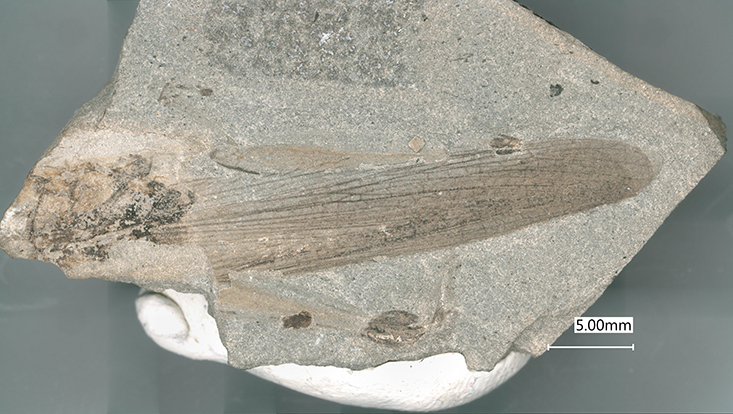
Are we experiencing the sixth mass extinction?
5 September 2019

Photo: UHH/CeNak
Fossilized insects, such as the specimen from the Piacenzian depicted here (found in Willershausen), allow us to draw conclusions about prehistoric habitats.
The most famous victims of any mass extinction were doubtlessly the dinosaurs: around 66 million years ago, they were suddenly wiped off the face of the Earth. At the fifth EGU Galileo Conference in Utrecht, geoscientists and biologists from all over the world discussed whether Earth is currently experiencing its sixth mass extinction and what past extinction events had in common. Ulrich Kotthoff, the head of the Geological-Paleontological Museum, was one of them. Together with other scientists from the Center of Natural History (CeNak), he researches insects and arachnids. At the conference Mass Extinctions, Recovery and Resilience, they reflected on the effects of sudden, severe changes in biodiversity.
An interview with Ulrich Kotthoff and the conference organizer, Bas van de Schootbrugge:
When is it appropriate to talk about a mass extinction?
Ulrich Kotthoff:
Biodiversity on Earth fluctuates naturally. Not every extinction constitutes a mass extinction. Over the past 500 million years, however, our planet underwent 5 events during which up to 90 per cent of all living species were eradicated in a relatively short space of time. Most of those mass extinctions were related to extremely intense volcanic activity. At least one of them, the extinction of the dinosaurs, was caused by the impact of a meteorite in the Gulf of Mexico.
Looking back, what conclusions can you draw?
Ulrich Kotthoff:
Even extinction events that took place extremely far in the past can help us understand the relationship between the extinction of species and the emergence of new ones, on the one hand, and that between climate changes, changes of marine chemistry, and tectonic processes, on the other.
How can you determine whether a mass extinction took place?
Bas van de Schootbrugge:
At the end of the Triassic, around 200 million years ago, malformed pollen grains suddenly appeared. This indicates environmental stress. Vegetation underwent rapid changes. The fossil report shows that after the Triassic ended, ferns spread across formerly wooded areas. There is also evidence of soil erosion during the Triassic-Jurassic extinction event, which was similar to current developments caused by the deforestation of Madagascar, for example.
Ulrich Kotthoff:
At that time, during the late Triassic, the North American and European continents were breaking apart to create the Atlantic Ocean. This caused enormous volcanic activity of a scale we can barely imagine nowadays. It released large quantities of CO2 and sulphur dioxide into the atmosphere. Today, the consumption of fossil fuels can yield similar concentrations.
Can we compare the ongoing decline of biomass and biodiversity among insects with the major mass extinctions?
Ulrich Kotthoff:
Unfortunately, we do not have a complete fossil report for insects, arachnids, and myriapoda, which makes it difficult to draw a direct comparison. Recapitulating their development via genetic analyses is not enough, as we would miss extinct groups and certain evolutionary adaptations. We also look at indirect indicators to form as accurate a picture as possible about the diversity of insects throughout Earth’s history. Changes in the feeding traces found on leaves are helpful, for example. Compared to other groups of animals, insects appear to be less affected by extinction events. This is due to their short generation times, the sheer number of animals per species, and the ability of many insects to withstand unpleasant environmental conditions during their egg, larva, or pupa stage.
What role does human influence play?
Ulrich Kotthoff:
A crucial difference between current and past extinction events is, indeed, that human beings are now deliberately destroying insects. In terms of CO2 production and changes to ecosystems, human impact may well be comparable to volcanic activity. But our use of insecticides and pesticides goes further than that: we willfully combat organisms we consider harmful. And we are happy to accept massive collateral damage.
Contact
Ulrich Kotthoff
Center of Natural History
Bundesstraße 55
20146 Hamburg
Tel: +49 40 42838-5009
Ulrich.Kotthoff@uni-hamburg.de(ulrich.kotthoff"AT"uni-hamburg.de)
